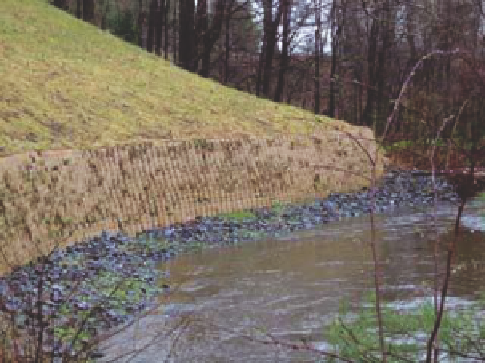Environmental Engineering Reference
In-Depth Information
8.4.24.3 Other Revegetation Techniques
A number of other revegetation techniques can be used for bank stabilization, such as bundles/fas-
cines, live siltation, brush mat, hedge-brush layering, vegetated cribbing, and grass rolls.
The vegetated geotextiles consist of alternating layers of live branch cuttings and com-
pacted soil with geotextiles (natural or synthetic; Figure 8.36). Geosynthetics are used as
reinforcement to strengthen the soil mass by interacting with the soil, creating friction or
adhesion, trapping sediments, and rebuilding streambanks. Their effectiveness increases
with time, as the vegetation becomes permanently established. Geosynthetics include (NRCS
2007c; Figure 8.37):
• Geotextiles: Are permeable geosynthetics comprised solely of textiles. They may be
woven or nonwoven and may be composed of monoilament yarns or monoilament
plastic.
•
Geogrids: Are geosynthetics formed by a regular network of integrally connected elements
with apertures greater than one-fourth of an inch to allow interlocking with the surround-
ing soil, rock, earth, and other materials to function primarily as reinforcement.
•
Geonets: Are geosynthetics consisting of integrally connected parallel sets of ribs overly-
ing similar sets at various angles.
•
Geocells: Are composed of polyethylene strips, connected by a series of offset, full-depth
welds to form a three-dimensional honeycomb system.
A brush mattress is a protective mat of cuttings placed on the streambank and staked suficiently
to hold it in place; it is the soil bioengineering version of rock riprap (Heaton et al. 2002). The mat
provides 100% coverage in the area in which it is placed and cuttings will root along the entire
length of the structure, providing long-term protection (Figure 8.38).
Live fascines are long bundles of branch cuttings, commonly willows, bound together in cylin-
drical structures. They are placed in shallow contour trenches on dry slopes and at an angle on
wet slopes to reduce erosion and shallow sliding (Figure 8.39; NRCS 1996b). They principally
protect the bank toe and face, but they may also be used as current delectors. Fascines can, as they
grow roots and cover, improve erosion control, iniltration and riparian zone functions (Sotir and
Fischenich 2001), and isheries habitats. Facines are simple and effective, requiring little time to
build and can be installed with little site disturbance (Heaton et al. 2002).
FIGURE 8.36
Geocell earth-retaining structure. (From NRCS, Stream restoration design,
National
Engineering Handbook
, Department of Agriculture, Natural Resources Conservation Service, 2007a.)

Search WWH ::

Custom Search